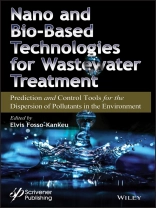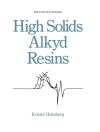Presents recent challenges related to new forms of pollution from industries and discusses adequate state-of-the-art technologies capable to remediate such forms of pollution.
Over the past few decades the boom in the industrial sector has contributed to the release in the environment of pollutants that have no regulatory status and which may have significant impact on the health of humans and animals. These pollutants also referred to as ‘emerging pollutants’, are mostly aromatic compounds which derive from excretion of pharmaceutical, industrial effluents and municipal discharge. It is recurrent these days to find water treatment plants which no longer produce water that fits the purpose of domestic consumption based on newly established guidelines. This situation has prompted water authorities and researchers to develop tools for proper prediction and control of the dispersion of pollutants in the environment to ensure that appropriate measures are taken to prevent the occurrence of outbreaks due to sudden load of these pollutants in the water system.
The chapters in this book cover a wide range of nano and bio-based techniques that have been designed for the real time detection of emerging contaminants in environmental water sources, geochemical models that are continuously improved for the prediction of inorganic contaminants migration from the mine solid wastes into ground and surface waters. Remediation strategies are also discussed and include effective techniques based on nanotechnology, advanced membrane filtration, oxidative and bio-degradation processes using various types of nanocatalysts, biocatalysts or supporting polymer matrices which are under advanced investigations for their implementation at large scale for the removal of recalcitrant pollutants from polluted water.
Nano and Bio-Based Technologies for Wastewater Treatment: Prediction and Control Tools for the Dispersion of Pollutants in the Environment is divided is two sections. The first section covers the occurrence of emerging pollutants in environmental water while the second section covers state-of-the-art research on the removal of emerging pollutants from water using sustainable technologies. A total of 13 chapters addressing various topics related to the two sections are essentially based on recent developments in the respective field which could have a significant impact on the enhancement of the performance of wastewater treatment plants around the world, and especially in developing countries where access to clean and safe water remains a daily challenge.
Tabella dei contenuti
Preface xv
Part 1: Occurrence of Emerging Pollutants in Water and Possible Risks 1
1 Geochemical Prediction of Metal Dispersion in Surface and Groundwater Systems 3
Martin Mkandawire
2 From Priority Contaminants to Emerged Threat: Risk and Occurrence-Based Analysis for Better Water Management Strategies in Present and Future 41
Hussein N. Nassar and Sherif A. Younis
3 Advances in Chromatographic Determination of Selected Anti-Retrovirals in Wastewater 105
Gbolahan Olabode and Vernon Somerset
4 Liquid Extraction and Determination of Selected Organophosphorous Pesticides in Wastewater and Sediment Samples 129
Vernon Somerset and Luleka Luzi-Thafeni
Part 2: Nano and Bio-Based Technologies for Wastewater Treatment 147
5 Coal Power Plant Wastewater Treatment by Thermal and Membrane Technologies 149
J.G. Redelinghuys, E. Fosso-Kankeu, G. Gericke and F. Waanders
6 PAHs Released From Coal Tars and Potential Removal Using Nanocatalysts 169
N. Mukwevho, E. Fosso-Kankeu and F. Waanders
7 Green Synthesis of Nanoparticles for Water Treatment 205
Nour Sh. El-Gendy and Basma A. Omran
8 Carbon Nanotubes in the 21st Century: An Advancement in Real Time Monitoring and Control of Environmental Water 265
Sadanand Pandey, Gopal Krishna Goswami, Hussein Kehinde Okoro and Elvis Fosso-Kankeu
9 Sediment Microbial Fuel Cell for Wastewater Treatment: A New Approach 303
Sajana T.K, Soumya Pandit, Dipak A. Jadhav, Md. Abdullah-Al-Mamun and Elvis Fosso-Kankeu
10 Design of a Down-Flow Expanded Granular Bed Reactor (DEGBR) for High Strength Wastewater Treatment 339
M. Njoya, Y. Williams, Z. Rinquest, M. Basitere and S.K.O. Ntwampe
11 Phycoremediation: A Solar Driven Wastewater Purification System 373
Namita Khanna, Akshayaa Sridhar, Ramachandran Subramanian, Soumya Pandit and Elvis Fosso-Kankeu
12 Technologies for Remediation of Emerging Contaminants in Wastewater Samples 429
Charlton van der Horst and Vernon Somerset
13 Removal of Heavy Metal Pollutants from Wastewater Using Immobilized Enzyme Techniques: A Review 459
Soumasree Chatterjee, Soumya Pandit and Elvis Fosso-Kankeu
Index 481
Circa l’autore
Elvis Fosso-Kankeu has a doctorate degree from the University of Johannesburg in South Africa. He is currently an Associate Professor in the School of Chemical and Mineral Engineering at the North-West University in South Africa. His research focuses on the prediction of pollutants dispersion from industrial areas, and on the development of effective and sustainable methods for the removal of inorganic and organic pollutants from polluted water. He has published more than 120 papers including journal articles, book chapters and conference proceeding papers.












